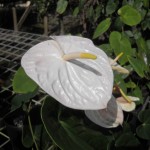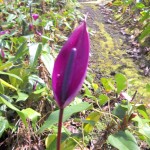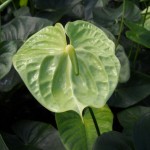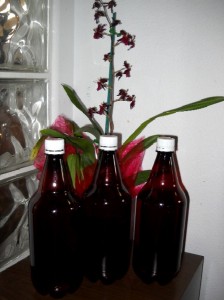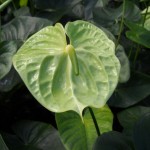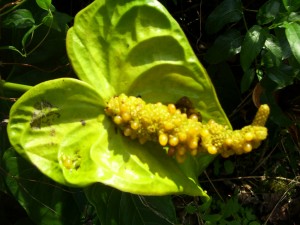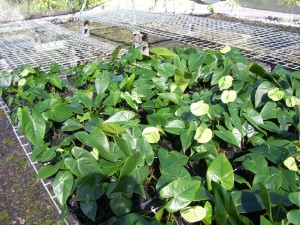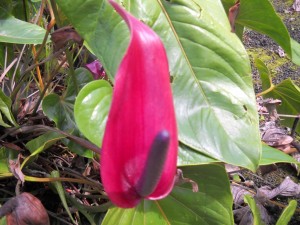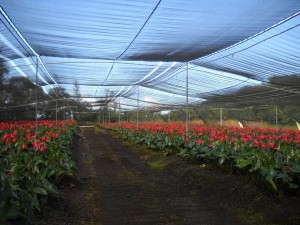White Anthurium
White is an interesting color. When you take all of the colors of the rainbow and you blend them together you get the color white. White anthurium flowers were created by mixing a number of different anthurium species together. In fact, a white anthurium hybrid called White Lady is the product of four different species which were crossed together in 1987.White Lady is an excellent plant to grow at home, because it makes a great potted plant. It is a very compact plant so it is capable of growing in a small pot in a small amount of space. It is also a very hardy plant and in fact it also demonstrates resistance to the bacterial blight. If treated well, it will produce six elongated tulip shaped flowers a year. These lovely flowers will acquire a slight hint of pink as the flowers mature. If you put these flowers into a vase, they will last up to 25 days.
Other white and off-white varieties include: Pua Kea, Ellison, Sister Grace and Limelight. Most of these types of flowers fall into the standard anthurium family as opposed to the tulip anthurium family like White Lady. Standard anthuriums are medium sized flowers that are heart shaped, while tulip anthuriums are smaller and of course tulip shaped. Tulip anthuriums are usually hybrids of the anthurium amnicola species, while standard anthuriums are generally hybrids of the anthurium andraeanum species.
White anthurium care is very straightforward. Put them near a sunny window, but do not allow them to receive full-strength sunlight or they will get sun burned. Make sure that they are kept at a temperature of 70 to 80 degrees. Water them regularly, but make sure that their soil is always well drained. Apply a small amount of slow release fertilizer once or twice a year. And that is pretty much all there is to it.
White anthurium flowers can be arranged in a number of ways. A simple arrangement could consist of 6 to 12 flowers all by themselves. More complex arrangements could consist of pinks and whites; or whites, pinks and reds. You could also mix them with other flowers. They go really well with orchids and green tropical foliage. If you really want to push the envelope, you could arrangement them with red anthuriums, lilies and roses, as well.
Purple Anthurium: An Anthurium Andraeanum and Amnicola Hybrid
Purple anthurium plants produce a stunning tulip shaped flower in a very pleasing shade of purple. As you may already know, originally, anthuriums didn’t come in very many colors. In fact most of the colors that you see today were developed after the 1940s. Purple is a color that is even newer than that. I believe that it was first developed sometime after 1980.
Purple Anthurium Origins
This flower was created by crossing anthurium andraeanum with amnicola to produce a hybrid named andreacola. Andreacola appears to have inherited the best traits of both of its parent species. From the amnicola it received its ability to produce tulip shaped flowers, its compact size and its resistance to the bacterial blight. From the andraeanum it received an ability to produce larger flowers and a multitude of colors, which, of course, includes purple.
Tulip Anthurium Cut Flowers
As a cut flower, they are perfect for smaller arrangements because they are slightly smaller than regular anthuriums. They have a great vase life and will last for several weeks. They look great when arranged with pink and pastel green anthuriums or when arranged with white orchids. Another thing that sets this variety apart is that sometimes these flowers will have a very pleasant scent. Just about all other anthurium flowers are unscented, but sometimes these flowers have a great fragrance.
Excellent House Plants
They also make excellent houseplants. They are more compact than other varieties so they take up less space in your house. Furthermore they are even hardier than other varieties, so they are even easier to care for. The fact that they are blight resistant is another positive factor. This makes for one less thing that you have to worry about.
Ordering Tips
If you do decide to order one of these plants, try to order during a time of the year where the average daily temperature is 70 degrees and the range of temperatures is narrow. Temperatures that are too hot or too cold, during shipping, may harm these plants while they are in transit.
Taking Care of Your Purple Anthurium Plant
After you order, aim to have a spot for your new plant set up before it arrives. The ideal location has a number of characteristics. First, the temperature should be near 70 to 80 degrees and it should not fluctuate much from this ideal. Second, this spot should be well lit but it must not receive direct sunlight. Direct sunlight can burn your plant. Third, high humidity is ideal, but you can compensate for low humidity by misting your plant with water every day.
As far as caring for your new plant, the main this is: remember to water it regularly. Ideally, you should water it everyday. This is what wild anthuriums are accustomed to receiving in the rain forest, but you must also make sure that all of the water drains away from the roots of your plant rapidly. If the roots remain in contact with water for too long they can suffer root rot and this can harm your plant.
Green Anthurium aka Midori Anthurium Plants
So far no one has been able to breed a blue anthurium, though I am sure that if scientists put their minds to it they could do so, much like they have done to create blue roses in the lab. As of now, the closest we can come to blue is the color green, at least green is next to blue in rainbows. Green anthurium plants are also known as Midori anthuriums.
We sell large green anthurium flowers for $3.50 per stem and plants for $29 per top cutting.
Click Here To See Our Catalog.
Green Anthurium Origins
This variety was created by a grower named Calvin Hayashi in 1985, right here, on the Big Island of Hawaii. I believe that the Midori is one of the most innovative varieties as it was the first and still the only variety of anthurium that is truly green. There are other varieties that may have some green in them or possess an off shade of green, but only the Midori is just solid green.
Vase Life
Another trait that makes this variety special is its vase life. It has one of the longer vase lives of all of the anthurium flowers. It can last a month or even more in a vase, if handled properly after being harvested. Proper handling consists of trimming half an inch off the bottom of their stems as soon as you receive them, placing them in clean water and making sure you put them in a room where the temperature stays close to 70 degrees.
An Interesting Phenomena
One interesting thing you’ll notice if you buy a green anthurium plant is something that growers actually try to avoid. When these flowers are left on the plant for too long, they start to change color. Growers obviously do not want to see this happen, but if you are like me, you’ll find that this actually makes them look even more interesting. If you leave the flowers on your plant, rather that putting them in a vase, you’ll find that they will develop copper colored highlights that contrast nicely with their regular smooth green surface.
Midori Anthurium Care
To keep your Midori alive, the number one rule is: don’t forget to water it. If you remember only one thing from this article, I hope that you remember that. These plants need to be watered regularly; they come from rain forests, after all. Next, after watering, make sure that all excess water is drained away and removed from the pot. If water is left in the pot it can cause the root system of your plant to rot away. Always, keep your plant in a room with a stable temperature, around 70 degrees. You can put it near a window, but block direct sunlight with a thin, gauzy curtain, so that your plant can receive filtered sunlight to avoid burning. Finally, give it a small amount of slow release fertilizer before the growing season in your area.
Hawaiian Drinks: A Brief Guide To Hawaii’s Tropical Drinks
Hawaii is home to beautiful beaches, active volcanoes and beautiful flowers like ginger and anthurium flowers. In Hawaii, you can also find several drinks have become closely associated with the islands. Few people fail to think of Mai Tai’s or Blue Hawaii’s, when the drinks of Hawaii are mentioned. But Hawaii also offers a special type of coffee and an exotic drink called kava. Here are a few of my favorite Hawaiian drinks.
Mai Tai
Almost everybody who visits Hawaii has heard of the legendary drink called the Mai Tai. But did you know that this drink wasn’t invented here. It was invented by a man named Donn Beach who owned a restaurant in California. Beach’s recipe consists of rum, orange curacao and orange juice. Beach seems to have the perfect surname for a man whose drink is sipped on the beaches of Hawaii.
Kona Coffee
A man named Samuel Ruggles brought the first coffee plant to Kona in 1828. Kona’s unique weather and fertile soil produces a coffee that surpasses nearly all other coffees in the world. The only comparable coffee outside of Kopi Luwak (which is not for the squeamish) is probably Jamaica’s Blue Mountain coffee. Kona coffee is grown on over eight hundred farms that are located in the districts of North or South Kona. Only coffee cultivated in these two districts can be called Kona Coffee.
Blue Hawaii
The Blue Hawaii was created by Harry Yee in 1957. Yee came up with the Blue Hawaii, which is a combination of vodka, rum, blue curacao and pineapple juice, after being asked by a product sales representative of the Bols Company to create a drink featuring their new Blue Curacao liquor. Obviously, it was a big hit. The Blue Hawaii, with its signature blue color, has become a popular drink in Hawaii.
Kava
Kava is grown all over the pacific. Early polynesian voyagers introduced kava to Hawaii and have been having it for centuries. Kava appears to calm the mind and body, and also seems to foster sociability. But be forewarned, most people who try kava for the first time say that it is one of the most horrible tasting drinks they have ever tried.
Mauna Kea Observatories
Did you know that the largest astronomical observatory in the world is located in Hawaii? Well it is, the summit of Hawaii’s Mauna Kea Mountain is home to thirteen telescopes. The total light gathering capacity of these telescopes is fifteen times greater than the Palomar telescope, which used to the largest telescope in the world. Mauna Kea is home to several of the largest telescopes in the world, including the largest optical telescope, the largest infrared telescope and the largest submillimeter telescope.
Mauna Kea, which means “white mountain” in Hawaiian, is aptly named as it is covered in a thick white blanket of snow for most of the year. It is the highest point in the Pacific and it is the highest island mountain in the world, measuring 32,000 feet from its base on the ocean floor to its summit. This is higher than Everest, which is 29,000 feet.
Mauna Kea is the ideal location for setting up telescopes to look deep within the universe. The air above it is some of the driest in the world. Clouds are almost never an issue as it has an incredibly high number of cloud free nights, which allow uninterrupted observation. It also has a tropical inversion layer which traps pollutants and moisture thousands of feet below the summit. This ensures that the summit has extremely clear air, which is important when gazing far into the universe.
The actual telescopes are off limits to the public, but you can still visit the summit. Be prepared for extremely cold and windy conditions. Also, you must be prepared for the altitude which is close to 14,000 feet. Altitude sickness can be a big issue for some people.
You should stop at the Onizuka Center before proceeding to the summit. The center is located at an elevation of 9,300 feet and stopping there will give your body a chance to acclimatize to the elevation. At the center you can see exhibits about Mauna Kea and its observatories.
Anthurium Flowers and Plants
ANTHURIUMS are one of the most beautiful flowers in the world. ANTHURIUM FLOWERS are produced by ANTHURIUM PLANTS, which are members of the genus ANTHURIUM. This genus consists of over eight hundred ANTHURIUM SPECIES and hybrids like OBAKE ANTHURIUM. ANTHURIUM CARE is easy and consists of finding the right place to put them and watering them properly. HAWAII is one of the first places in the world to grow anthuriums commercially.
Anthurium Propagation: Seeds, Cuttings & Tissue Culture
There are three ways to propagate anthurium plants: you can take cuttings; you can grow them from seeds; or you can tissue culture them. Cuttings are easy for anyone to do. Seeds are a little more difficult to do, and tissue culture is generally reserved for scientists in labs or really advanced anthurium cultivators.
Anthurium Cuttings
Cuttings are by far the easiest way to propagate your anthurium plant. The best part about taking cuttings is that the plants you produce will look exactly the same as the parent plant. First, you must wait until your plant is big enough to allow a cutting to be taken. Generally you’ll want to see at least four nodes, or sets of leaves and roots, before taking a cutting. Once your plant is big enough, cut it in half, so that each portion has at least two nodes. Leave the base of your plant in its original pot and it will generate new growth. Then put the top cutting into a new pot, water it regularly and it will keep growing, too.
Anthurium Seeds
Anthurium seeds are another way to propagate your plant. However it is a much more difficult process and takes a lot more patience. The stigma and stamen of these flowers are active at different times, so if you want to produce seeds you will have to store pollen in the freezer or have two flowers at different stages of development. So the first thing you have to do is gather pollen. Use a paint brush to scrape pollen off the stamen and into a vial. Keep this vial in the freezer until you see that the stigmas are ready to be pollinated. Once you have a flower with receptive stigmas dust a little pollen over it. Next you will have to wait for approximately a year for seeds to be produced.
Anthurium Tissue Culture
Tissue culture is almost exclusive done within the confines of a lab, with the exception of really high end hobbyists and growers. It is best left to commercial growers because it is very expensive and is generally used when one wants to produce thousands of genetically identical plants. So how does an anthurium farmer tissue culture an anthurium plant?
First, the anthurium farmer chooses an ideal specimen. This specimen will be replicated thousands of times, so a lot of time and effort is put into choosing the very best specimen available. Once this precious plant is selected, the farmer takes it to a lab.
In the lab, a scientist confirms that the specimen is healthy and then chops off a piece of it. Then the scientist will sterilize the sample and put it into a beaker that contains an agar based gel. This beaker also contains special plant hormones that trigger the sample to form a callus, which is an undifferentiated mass of plant cells.
The callus is divided into many portions and then allowed to grow once more. This method is replicated multiple times. Once sufficient material is created, the calluses are moved to a growing media which contains plant hormones that cause the undifferentiated cells to transform into roots and shoots. This causes hundreds of plantlets to sprout from every callus.
After the plantlets have grown sufficiently, they’re transplanted into brand new flasks to mature further. Once they have reached a size where they can survive in open air, they are removed from the beakers and transferred into pots. These new plants are allowed to mature in the tightly controlled conditions of a plant nursery for a while. Then, after they have adjusted to growing in open air, they’re returned to the farmer for transplanting into his fields.
Anthurium Seeds: A Brief Guide To Anthurium Pollination
Most people propagate their anthurium plants through cuttings. But the downfall of this approach is that the offspring that is produced is identical to the parent plant. If you want variety in the anthurium flowers that you produce, you will need to learn how to pollinate your anthuriums in order to get them to produce seeds. The plants that you grow from these seeds will have traits from both of their parent plants, but sometimes you can get something completely unexpected due the presence of recessive traits. The most challenging element about growing anthuriums from seeds is getting the seeds to form in the first place. To do this, you will need to learn about anthurium pollination.
These flowers have both male and female components, but usually they won’t self pollinate, because the stigma is active before pollen is produced. This ensures that wild plants are cross pollinated as frequently as possible to improve the genetic diversity of the species.
The first thing you must do is gather pollen. Wait until the flower produces pollen and use a brush to collect the pollen in a vial. Store this vial inside a freezer until another flower is ready for pollination. Or use the pollen immediately if another flower is already ready for pollination.
After a flower blooms, wait for the stigma to secrete nectar. When this happens, the flower is ready for pollination. Use your brush to dust pollen over the stigmas. Then all you need to do is wait until seeds are formed.
You may have to wait for a full year for the seeds to mature. They are mature when they stop growing and start to fall off the spadix. Pop the berries that contain the seeds and plant them immediately. After a couple of weeks, the seeds will begin to grow and then, you will only have to wait another two to three years to find out what the new flowers you have created will look like. It takes about two to three years for anthuriums to produce their first flowers after sprouting from seeds.
Anthurium Potting Soil: How To Create The Ideal Potting Soil For Anthuriums
Choosing or making the ideal anthurium potting soil is important if you wish to grow a healthy anthurium plant. If you use a bad potting soil, your anthurium may grow slowly, stop flowering and even die. Before I tell you how to create the ideal anthurium potting soil, I am going to give you a little background on the growing media that wild anthuriums grow in, so that you can understand what makes for a great potting soil.
Wild anthuriums don’t grow in pots. I hope that this isn’t a big surprise. They come from South America and they grow in tropical jungles, primarily upon the trunks of trees.
Growing on trees allows them to receive a lot of water from rain and fog, and it allows this water to drain away rapidly. They’re unusual plants because they love moisture, yet continuous exposure to moisture can kill them. Growing on trees allows them to keep their roots out of standing water and allows their roots to receive plenty of oxygen.
When choosing or making a potting mix you must remember the reason why they grow on trees. Most out of the box planting mixes retain too much water. So if you use these types of mixes your plant may die from being exposed to too much moisture. The surplus water may prevent oxygen from reaching the roots and allow anaerobic bacteria and fungi to grow.
You can prevent this by making your own potting mix. Your mix needs to drain well and it ought to be light and loose to keep your anthurium healthy. Here are two excellent potting mix recipes.
High End Anthurium Potting Mix
This mix will cost you an arm and a leg. Well, maybe not that much. But it is probably one of the better all around mixes for anthuriums. I must warn you, it will take a little work to procure all of the ingredients and mix them well. The links in the recipe below will take you to Amazon.com where you can buy the ingredients if you can’t find them in your local garden store.
5 parts Miracle Gro moisture control mix
2 parts peat moss
2 parts orchid mix
1 part perlite
To make this, just find something to use as a measuring device, like a pot. Then put five scoops of the miracle grow potting mix, two scoops of the peat moss, and so on, into a large container and mix thoroughly.
To save time, I would recommend mixing up more than you need at the moment and storing the excess in a water proof bag or container for when you need to repot your anthuriums in the future.
Simple Anthurium Potting Soil
If you don’t want to go all out with the high end potting mix, you can use this potting mix recipe, instead. It will still work well and it costs less and is easier to make.
1 part peat moss
1 part fir bark
1 part perlite
The same instructions, as above, apply. Mix thoroughly and make more than you need to save time in the future.
Hawaiian Anthurium Potting Mix
When you are growing a lot of anthuriums and I am talking in the tens of thousands (I’ve never counted) it is simply not economical to use commercial potting mixes. But here in Hawaii, the solution is simple and economical. We grow our anthuriums in volcanic cinder. It drains really well, but it also has a lot of pores so it holds on to just the right amount of water too.
We buy cinder by the truck load for our farm. But if you don’t happen to have a cinder cone a few miles away, either of the potting mix recipes that I described above should work well for you.
Anthurium Farming: How Anthurium Growers Raise Anthurium Flowers
In Hawaii, growing anthurium flowers is a big business. Anthuriums are grown on more than two hundred commercial farms. Some of these farms have been in business since the 1950s, which was the decade that farmers first started growing anthuriums commercially. Keep reading and I will describe the techniques that these farms use to grow massive quantities of anthurium flowers.
The first step in growing these flowers commercially is building a shade house. The purpose of the shade house is to provide shade to the plants that will be grown in it. The reason why shade is vital to growing anthuriums is that these plants would tend to get burned by the sun if they were to be grown in direct sunlight. To build a shade house, the parcel on which it is going to be built must be cleared and graded with a bulldozer. After the land is leveled off, galvanized pipes are set in place. These pipes are used as columns to support the cables and shade cloth that are used to construct the shade house.
After the shade house is completed, volcanic cinder or other growing media is distributed on the ground of the shade house using tractors. The cinder normally comes from volcanic cinder cones and is brought to the farm in large dump trucks. Usually a layer of cinder about two feet thick is placed on the floor of the shade house.
Once the cinder is in position, anthurium plants are acquired. They can originate from top cuttings of more mature plants in other parts of the farm or they can be the result of vegetative propagation. They are then planted in the shade house.
Usually, Hawaii’s frequent rain showers provide enough moisture for the plants. But, when the rainfall is insufficient the anthurium plants may be watered through overhead sprinklers.

